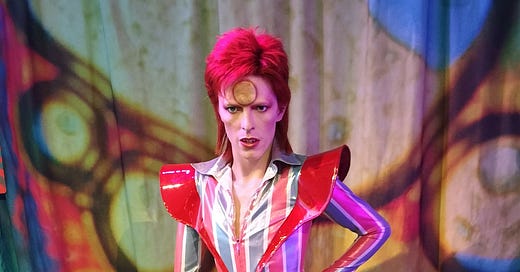MONSTER MASH
“Monster” is a wide net for anything you find monstrous—ghosts, freaks, zombies, big bugs, everyone from Hitler to your average bullied school shooter—but the thread running through this Monster Mash series I’ve been immersed in for a few weeks is the oozy mash part, the metamorphosis.
Some say it’s the artists who cannot be compartmentalized—not by gender, not by genre, not by race (think petit Prince, Michael Jackson losing his nose and his color, chameleon David Bowie, Lady Gaga sometimes rumored to have a hidden penis)—who are the most enduring/alluring, and perhaps also the most terrifying to those who require such clean containers and labels. Some can’t look; others can’t look away. Gaga embraces her inner monstrosity so much that she started referring to her fans as Little Monsters while she became their Mother Monster, hands in a cramped/claw position as she drags her body across the stage.
As an artist, most especially a musical one—except for maybe if you’re a Rolling Stone and can perform the same schtick until you croak—you’re almost required to constantly reinvent yourself. Metamorphosis is radical change, and change can be both horrifying and thrilling.
From Merriam-Webster, metamorphosis by definition, myth, and science:
a. Change of physical form, structure, or substance especially by supernatural means. the metamorphosis of humans into animals
b. A striking alteration in appearance, character, or circumstances. The company has gone through a series of metamorphoses.
Typically marked and more or less abrupt developmental change in the form or structure of an animal (such as a butterfly or a frog) occurring subsequent to birth or hatching. the metamorphosis of caterpillars into butterflies
Many ancient myths end in a metamorphosis. As Apollo is chasing the nymph Daphne, she calls on her river-god father for help and he turns her into a laurel tree to save her. Out of anger and jealousy, the goddess Athena turns the marvelous weaver Arachne into a spider that will spin only beautiful webs. But natural substances may also metamorphose, or undergo metamorphosis. Heat and pressure over thousands of years may eventually turn tiny organisms into petroleum, and coal into diamonds. And the most beloved of natural metamorphoses (notice how this plural is formed) is probably the transformation of caterpillars into butterflies.
Nymphs, of ancient Greek folklore, are, according to Wikipedia, “minor female deity…generally regarded as personifications of nature, typically tied to a specific place or landform, and usually depicted as maidens.” There also happen to be several nymph butterfly species also tied to place—the brown wood-nymph of North America with its wing eyeballs and the black and white tree nymph of the rainforests of Southeast Asia.
BUTTERFLIES IN A BLENDER
Franz Kafka and metamorphosis have become synonymous due to his classic dark saga of man-turned-insect. An interesting footnote to what I explored last week about how he never meant for that creature to be confined to any exact species or image, comes from author Vladimir Nabokov. A trained entomologist, Nabokov later teaches this story to his students, defying Kafka’s wishes to never show the thing itself by drawing his idea of the infamous insect and its six legs from two perspectives right into his page notes.
But Nabokov was most obsessed with butterflies, specifically as a lepidopterist who collected and pinned them down for display en masse, much like, say, his old dirty narrator Humbert Humbert tries to entrap his underage “nymphet” Lolita, 12-year-old Dolores Haze. Unlike most pre-teen girls, the most compelling thing to me about butterflies is how they get utterly reconstituted in their metamorphosis rather than just get cranky with a period. In the pupa or chrysalis phase, a caterpillar turns to absolute mush—body tissue completely breaking down to reform into legs, body and wings wholly different from where it began—much like I shared in an interview about what motherhood might do to a woman:
In an installment of Heidi Fiedler’s Substack Q&A series on Mothers Who Make, I wrote in answer to her question, How did motherhood change your creative practice?,
No one tells you how motherhood hijacks your brain, body and being and sort of puts it all in a blender, creating a metamorphosis slurry that will never again resemble what you used to be. You might emerge better–someday–but certainly not the same.
ROGUE METAMORPHS
I haven’t really played a video game since the original Pong, but if I were forced maybe this weird world of PoE suits me. In my explorations of metamorphosis online I came upon descriptions I do not pretend to understand of the Metamorphs who used to roam the Path of Exile (PoE) video game, or the monsters crafted by players from various monster organ samples (brain, eye, heart, liver, lung). Metamorphs are no longer in the core game, so here’s historical content from the official website:
Take a clean knife and cut a sample of flesh. Repeat. Four times. Mix the five samples in aquathaumatic solution. Heat. Stand back. The intrinsic darkness will make itself known. Observe its anger, its aggression. Observe its changing form, never comfortable to stay in one shape for long. It will try to kill you... Best not let it. Plunge the clean knife repeatedly... Hm. Try more heat. More! Perfect. Only every living creatures to go.
In Metamorph, you’ll meet Tane Octavius, a master alchemist who studied in Oriath. Exiled to Wraeclast for killing his teacher, Tane searches for what makes the “self,” by using his learned alchemical knowledge to assemble monster essences. He hopes to find a cure, or perhaps just the source, for what he calls “the intrinsic darkness” that led to his unforgivable violence.
In this ever-changing vernacular of the game, naturally spawning Metamorphs were also known as Rogue Metamorphs; organs can be possessed by a Tormented Spirit. As you assemble Metamorphs, there’s a helpful meter indicating the percentage of More Damage, More Maximum Life. The “rarer” the results the better.
The pervading question I had with this game called PoE was similar to someone else in the website forum, who asked, “Why Is This Game Named PoE, If Edgar Isn’t In It?”
There are hearts, but are they tell-tale?
FINESHRINE OF THE FLESH
The organ mess of the not-for-the-squeamish PoE, bring me to the lyrics of Purity Ring, which has pulled me of late with their first album in particular from over a decade ago. Purity Ring has this sweet delicateness about it until you listen closer and realize the body parts are piling up. The sexiness that could in other hands go a little violently nympho (since I seem to be covering all the declensions of nymph) here remains almost otherworldly.
Having just spent some time with Cronenberg’s The Fly, I appreciated coming upon this Straight article “Montreal’s Purity Ring evokes Cronenberg on visceral Shrines,” pulling these two worlds of movie and song together:
If there’s something a little chaste about how Purity Ring sounds, though, what [Megan] James sings is anything but. In contrast to her serene delivery, the lyrics to “Fineshrine” are literally visceral, with James inviting some significant other to “Cut open my sternum and pull my little ribs around you.”
It’s a sentiment as romantic as it is disquieting, seemingly born of a desire to merge with another in a way that goes beyond sex. Purity Ring’s songs seem somehow akin to the early work of fellow Canadian David Cronenberg, which was preoccupied with metamorphosis. Filmmaker Cronenberg once told Bomb magazine, “When I look at a person I see this maelstrom of organic, chemical and electron chaos; volatility and instability, shimmering; and the ability to change and transform and transmute.”
It’s not hard to imagine the director of Videodrome and The Fly appreciating “Belispeak”, which reads like something out of the Brothers Grimm: “Grandma, I’ve been unruly/In my dreams and with my speech/Drill little holes into my eyelids/That I might see you…when I sleep.”
I’ll spend another week with these lyrics and how they also hearken me back to the glory days of getting ripped apart from childbirth, but we can end this multi-sensory monster mashup with a song and man-cum-statue video:
What’s your favorite metamorph story? Have you experienced your own?








Geez, what is it with these Canadians?
I feel like I almost completely reinvent myself every 10 years or so. Like, I'm the same kid as I was, but I'm also very much not the same person I was at age 40.
I can't help but mention the two great scenes from The Fly that shocked me (the foot and the hand, if you get my meaning). I think I lost sleep over those!